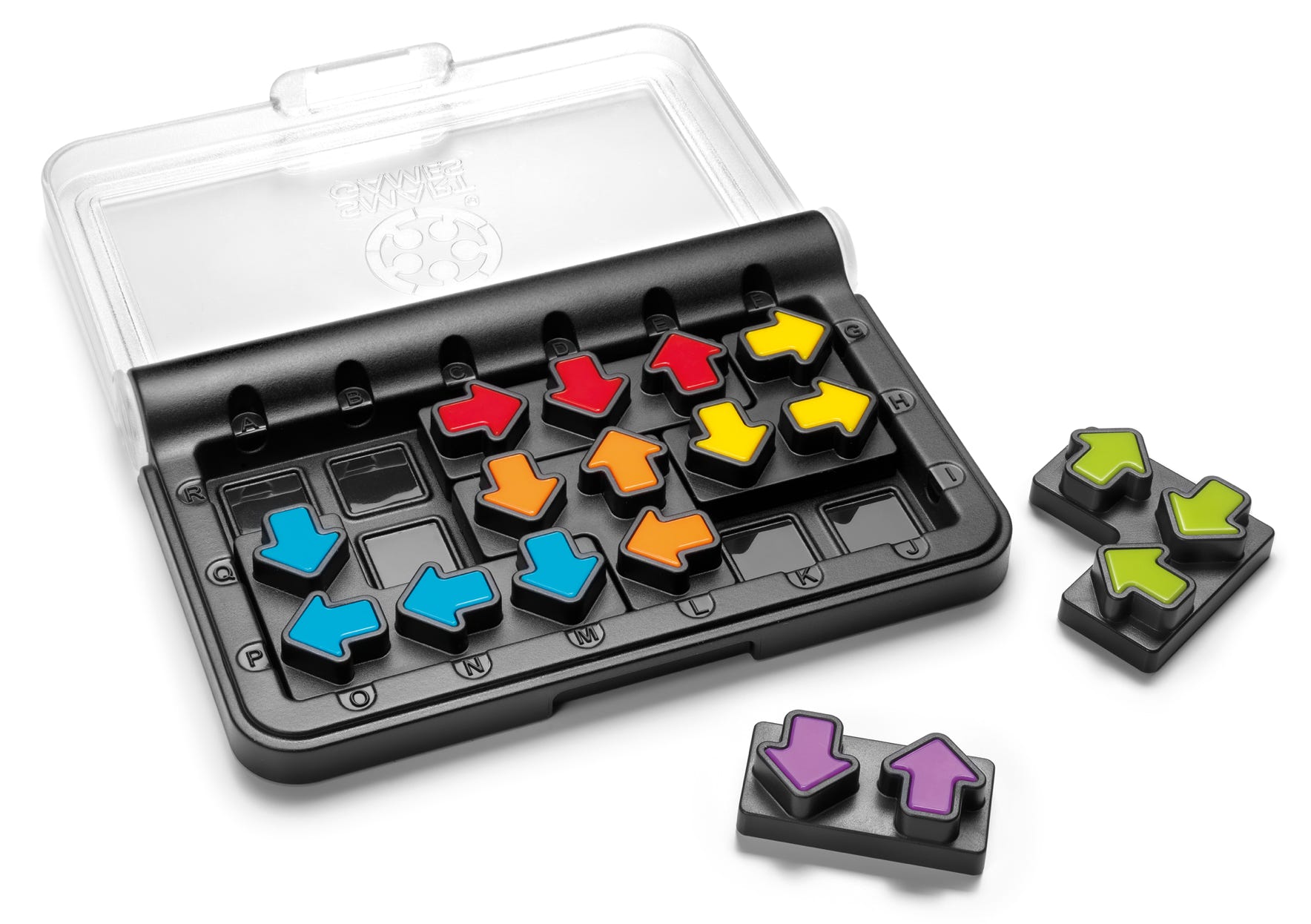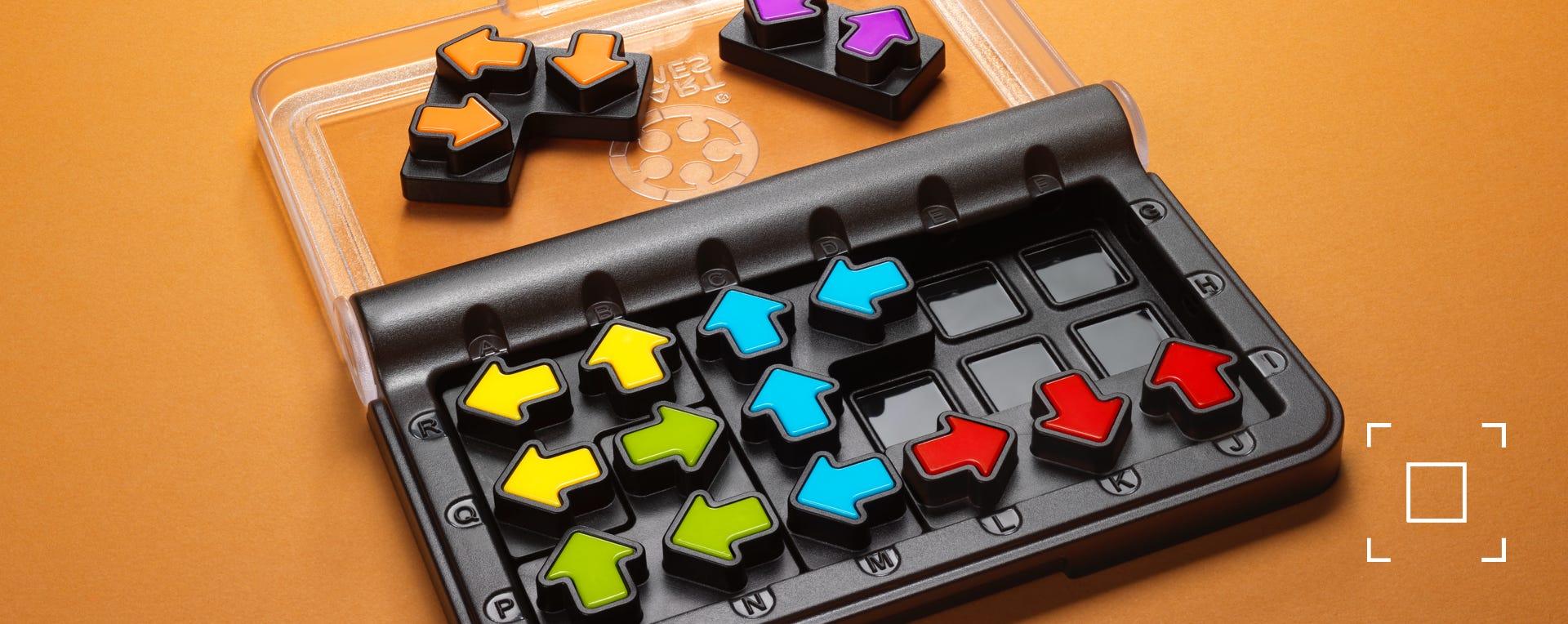
IQ-Arrows
The product development of IQ-Arrows (for SmartGames)
Raf Peeters, January 2020
Developing a new IQ-puzzle every year is both easy and difficult. It’s easy, because when you start you already know a lot of things about the final product:
- it needs to have a specific dimension, a rectangular game board and transparent lid
- it needs to have 120 challenges
- it’s going to be some kind of packing problem
- it’s probably going to be abstract and use a lot of colors.
At the same time it’s the hardest game to develop, because I already designed 8 different IQ-games over the last 9 years and I don’t want to repeat myself. It’s a fine balance between creating something familiar that at the same time is novel enough (but not too novel).
So every year I ask myself: what can I do different this time? A lot of the existing IQ-games give you hints about the position of specific puzzle pieces. Sometimes you only get part of this information in the challenge. Examples are IQ-Twist (the colored pegs), IQ-Focus (some colored squares in the centre) and IQ-Stars (some colored stars in the hardest level). BTW, this system of using color hints is also used in other SmartGames: both Cube Puzzlers, SmartCar Mini, Parking Puzzler and Deducktion all use colors to indicate the position of specific puzzle pieces. A red hint always indicate that a red puzzle piece, a red car, a red duck, etc, needs to be placed in that position.
For IQ-Arrows I also wanted to give hints, but the hints don’t refer directly to a specific puzzle piece. Each puzzle pieces features arrows pointing in different directions. The challenges show you the position and orientation of the arrows, but not their color (except for the starter level). Harder challenges show fewer arrows than easy challenges. The problem is of course that the orientation of arrows on a puzzle piece changes when you change the orientation of that puzzle piece. So if a challenge shows an arrow pointing to the right in the central part of the game board, this could be any arrow of any of the puzzle pieces! Of course when a challenge shows you an arrow in a corner or close to the edge, the number of possibilities to choose from goes down.
Solving this game sounds really complicated, but it’s not harder than any other IQ-game. This is partly because I kept the shapes of the puzzle pieces very simple. Also the grid is smaller than usual. It’s only a 3x6 grid instead of usual 4x8 of 5x10 grid, so you only need 6 puzzle pieces. There is a lot of variation between the different levels. The first level shows all arrows and the color of some. You normally start with placing the arrows that are colored and fill up the rest later. This is really simple. The junior level shows all arrows, but not their color. The problem here is that there is too much information at the same time visible to solve it. You can’ t look at the direction of 18 arrows at the same time! The strategy is to pick out one arrow or a combination of adjacent arrows that lead you to a specific puzzle piece. In the harder levels there is less information so focussing is not a problem. Sometimes you only get 3 or 4 arrows. In these challenges you need to look for the place on the game board where the number of possibilities is the lowest.
Sometimes the arrows shown in a challenge create some kind of simple pattern or all point in the same direction. This is done on purpose, because it helps players to memorise the challenge, so they don’t have to look constantly inside the booklet to check the challenge. Originally I planned to use the arrows in the Wizard level to create paths. For example to create a path with arrows going from one letter on the border to another letter. But this playing mechanism was too different from the other levels and really hard to explain, so I decided not to use it. But if you like to try it, below are the 8 routes that can be made (and that have a unique solution):
- from B to J (or from K to A)
- from D to P (or from M to G)
- from E to A (or from N to J)
- from G to P (or from P to G)
Maybe I keep this idea for a future product where it’s easier to implement.

example of a starter challenge (left) and solution (right) of IQ-Arrows

example of a junior challenge (left) and solution (right) of IQ-Arrows

example of a master challenge (left) and solution (right) of IQ-Arrows

GAME RULES IQ-ARROWS
1) Select a challenge.
2) Place all puzzle pieces on the game board so that the orientation of the arrows in your solution matches the challenge:
• Challenges in the Starter level show the orientation of all arrows and the colors of some.
• Challenges in the Junior level show the orientation of all arrows, but not their color.
• Challenges in the Expert, Master and Wizard levels only show the orientation of some arrows. The orientation of all other arrows is not important for the solution.
• All pieces need to be placed on the game board, even if they are not needed to show the arrows given in the challenge.
3) There is only one solution, which can be found at the back of the booklet.
Website ©2024 Raf Peeters
Products and images: © Smart
